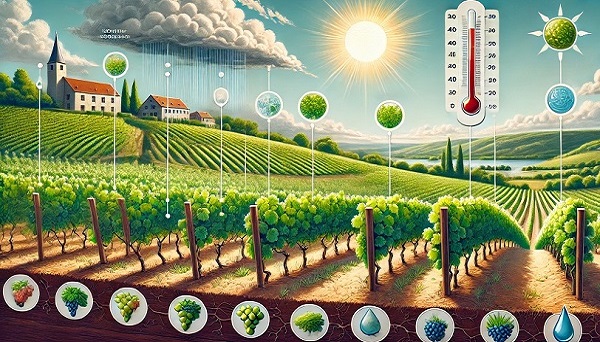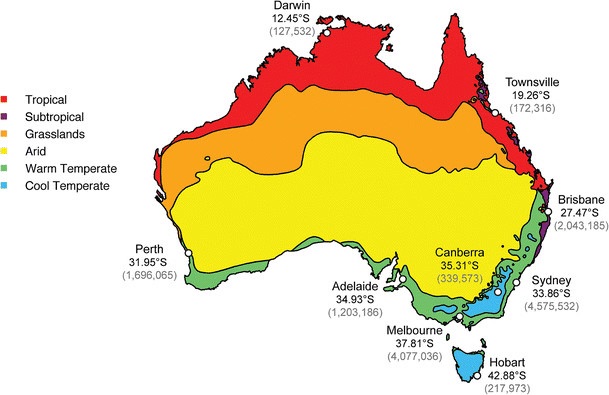Climate Factors

The climate factors which play a crucial role in grape ripening and flavor development are:
Average TemperatureSunlight Exposure
Rainfall and Frost
Humidity and Drainage
Wind
Climate and Microclimate
Climate influences temperature, rainfall, sunlight exposure, and humidity levels. All of this play a crucial role in grape ripening and flavor development.
Microclimates within a vineyard can further diversify grape characteristics, allowing for the cultivation of different grape varieties and styles of wine.
Within a single wine region, or even within a single vineyard, ther may be climate variations, due to differences in elevation, exposure to wind, or proximity to bodies of water. These microclimates can lead to variations in grape ripeness and flavor, allowing for greater complexity in the final wine blend.
Temperature
The average temperature, as well as temperature fluctuations, during the growing season significantly affect the ripening of grapes.
Cooler climates can result in higher acidity and slower ripening, while warmer climates can lead to riper, fruitier flavors.
If the growing season is too short or too cool, grapes may not ripen fully by harvest.
Average temparatures below 10°C (50°F) is too cold for winemaking.
Average temparatures over 20°C (68°F) is too hot for winemaking.

Most wine regions are located between 30 and 50 degrees latitude, and if you look at the map, you will also see that most wine regions have an average temperature between 10°C and 20°C.
Cooler Regions
Average growing season temperatures 13-15°C (55-59°F) in April to October on the northern hemisphere, October to April on the southern hemisphere.
Cooler regions include:
- Champagne (France)
- Chablis (France)
- Burgundy (France)
- Trentino-Alto Adige (Italy)
- Mosel Valley (Germany)
- Central Otago (New Zealand)
- Sonoma Coast (California, USA)
- Coastal Chile
White wines from cool climates tend to have citrus aromas, higher acidity, alcohol and a light body.
White wine grapes that do well in cool climates include:
- Riesling
- Müller-Thurgau
- Chardonnay
- Pinot Grigio
- Gewürztraminer
- Sauvignon Blanc
- Albariño
Red wines from cool climates tend to have red berry aromas, higher acidity, lower alcohol and a lighter body.
Red wine grapes that do well in cool climates include:
- Pinot Noir
- Cabernet Franc
- Cabernet Sauvignon
- Gamay
- Merlot
- Lagrein
- Schiava
- Zweigelt
Warmer Regions
Average growing season temperatures 17-20°C (63-67°F) in April to October on the northern hemisphere, October to April on the southern hemisphere.
Warm-climate viticulture has the opposite problem. Growers struggle to retain acidity in the grapes, making wines tasting stewed, shapeless or flabby.
Warmer regions include:
- Southern France
- Southern Italy
- Spain
- Greece
- Australia
- South Africa
- California (USA)
- Argentina
Red wine grapes that do well in hot climates include:
- Zinfandel
- Malbec
- Syrah
- Tempranillo
- Sangiovese
- Primitivo

Rainfall
Adequate rainfall is essential for grapevine health, but excessive or untimely rainfall can dilute flavors and increase the risk of disease.
Regions with a balance of wet and dry periods can produce more consistent wine quality.
Wind
Wind is one of the environmental features of wine regions. Wind can cool a warm climate or warm a cool climate.
Ocean Cooling
Ocean currents can be a useful temperature moderator in wine regions.
A vineyard in a warm region, close to a cold ocean, will benefit from the cooling ocean currents.
A vineyard in a cool region, close to a warm ocean, will benefit from the warming ocean current.
Notable Cold Climate Regions
Europe
Chablis, France: Renowned for Chardonnay.
Mosel, Germany: Known for high-quality Riesling.
Trentino-Alto Adige, Italy: Produces minerally white and sparkling wines.
USA
Oregon: Known for Pinot Noir and Pinot Gris.
Washington State: Produces Riesling and Chardonnay.
Finger Lakes, New York: Famous for Riesling.
South America
Argentina: The Patagonia region is known for producing Pinot Noir and Malbec in cooler climates.
New Zealand
Marlborough: Famous for Sauvignon Blanc.
Central Otago: Known for Pinot Noir.
South Africa
The Walker Bay region is known for Pinot Noir and Chardonnay.
Cool Climate Regions in Australia

Climate zones Australia. Source: Patterson Ross et al. 2015.
Australia has several cold-climate wine-growing regions, known for producing high-quality wines, particularly Pinot Noir, Chardonnay, Riesling, and sparkling wines.
These regions are characterized by cooler temperatures, higher altitudes, or maritime influences, which allow for slow grape ripening and the development of complex flavors:
Tasmania
Tasmania is an island 240 kilometres to the south of the Australian mainland. The capital and largest city is Hobart. The climate is maritime, with sea coled temperatures year-round.
The region produces Sparkling Wines, Pinot Noir, Chardonnay, Riesling and Sauvignon Blanc.
Yarra Valley (Victoria)
Located near Melbourne, in the foothills of the Great Dividing Range. The climate is cool to moderate, with significant temperature variation.
The region produces Pinot Noir, Chardonnay, Shiraz (cool-climate style), and Sparkling Wines.
Notable Features: One of Australia's oldest wine regions with a focus on artisanal winemaking.
Mornington Peninsula (Victoria)
Located south of Melbourne, surrounded by Port Phillip Bay and Bass Strait, the climate is Maritime, with cooling sea breezes.
Key Varieties : Pinot Noir, Chardonnay, Pinot Gris, and Shiraz.
Notable Features: Boutique wineries specializing in elegant, small-batch wines.
Adelaide Hills (South Australia)
Located east of Adelaide, in the Mount Lofty Ranges. The climate is cool to moderate, with high-altitude vineyards.
Key Varieties :Sauvignon Blanc, Pinot Noir, Chardonnay, and Shiraz.
Notable Features: Known for fresh, vibrant wines with high acidity.
Macedon Ranges (Victoria)
Location
North of Melbourne.Climate
One of Australia's coolest regions, with significant diurnal temperature variation.Key Varieties
Sparkling Wines, Pinot Noir, Chardonnay, and Riesling.Notable Features
High-altitude vineyards and artisanal wineries.
Great Southern (Western Australia)
Location
Southernmost wine region in Western Australia.Climate
Cool, with coastal influences.Key Subregions: Denmark, Mount Barker, and Porongurup.
Key Varieties
Riesling, Pinot Noir, Chardonnay, and Shiraz (cool-climate style).
Orange (New South Wales)
Location
In the Central Tablelands, west of Sydney.Climate
Cool to cold, due to high-altitude vineyards.Key Varieties
Chardonnay, Pinot Noir, Sauvignon Blanc, and Shiraz.Notable Features
Vineyards at elevations up to 1,000 meters above sea level.
Southern Highlands (New South Wales)
Location
Between Sydney and Canberra.Climate
Cool and maritime, with high-altitude vineyards.Key Varieties
Pinot Noir, Chardonnay, Sauvignon Blanc, and Riesling.Notable Features
A newer wine region gaining recognition for elegant wines.
Canberra District (New South Wales)
Location
Near Canberra, straddling the border of NSW and ACT.Climate
Cool to moderate, with continental influences.Key Varieties
Riesling, Shiraz (cool-climate style), and Pinot Noir.Notable Features
Renowned for high-quality Riesling and unique Shiraz-Viognier blends.
Alpine Valleys (Victoria)
Location
North-east Victoria, near the Snowy Mountains.Climate
Cool, with high-altitude vineyards.Key Varieties
Chardonnay, Pinot Noir, Prosecco, and Sauvignon Blanc.Notable Features
Emerging region with a focus on Italian varieties.